White Fillings
Many cavities can be easily fixed using a white filling that mimics the color of the natural tooth. White colored fillings are called composite resins. A composite is a plastic material that contains microscopic filler particles (usually quartz or silica) to give it added strength. It actually bonds to the tooth so that it will stay in place well. White fillings do have their limitations and often teeth with very large cavities with a lot of tooth structure missing are not good candidates for white fillings.

We remove the decay and shape the tooth with a dental handpiece. We treat the tooth with some bonding materials and then we add the composite resin (white filling). The composite material is putty-like and we can shape it so that it ends up looking just like the tooth originally did. We shine a bright UV light on the tooth and this light causes the composite to harden very similar to tooth structure. We polish up the filling and the next thing you know we have completed a white tooth colored filling that looks almost exactly like the original tooth!
Stainless Steel Crowns
Unlike small cavities that can usually be restored with white fillings, larger cavities that have destroyed a lot of tooth structure often have to be restored with a stainless steel crown. In addition, teeth with smaller cavities that have weakened enamel in the areas around the cavity often require stainless steel crowns as well. Stainless steel crowns cover the entire tooth and strengthen and protect it. Stainless steel crowns are much less expensive than adult crowns.
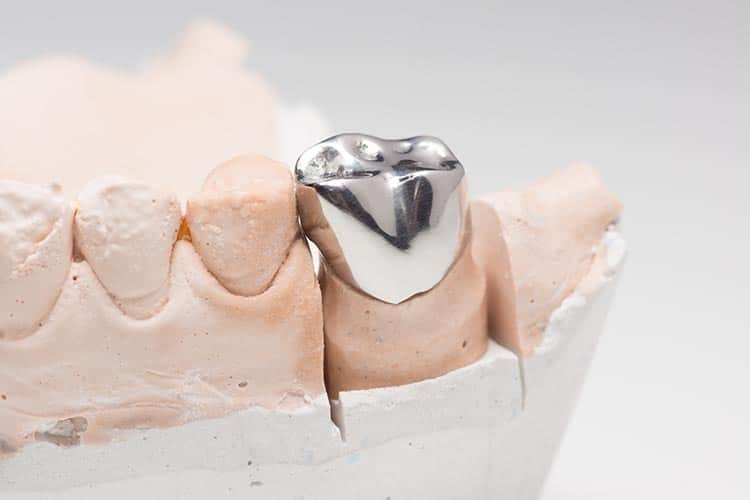
Many adults associate their children getting stainless steel crowns with the procedure that a parent may have gone through to get a permanent crown. The procedures are actually very different. Adult permanent crowns are often made of porcelain or gold and have to be custom made in a dental laboratory. They usually require two appointments, one to prepare the tooth for the crown and one to cement the crown. Stainless steel crowns on the other hand are pre-made in various different sizes. We simply find a size that fits your child’s tooth and then we can contour and adapt the crown to fit perfectly and then cement it in place all in one appointment.
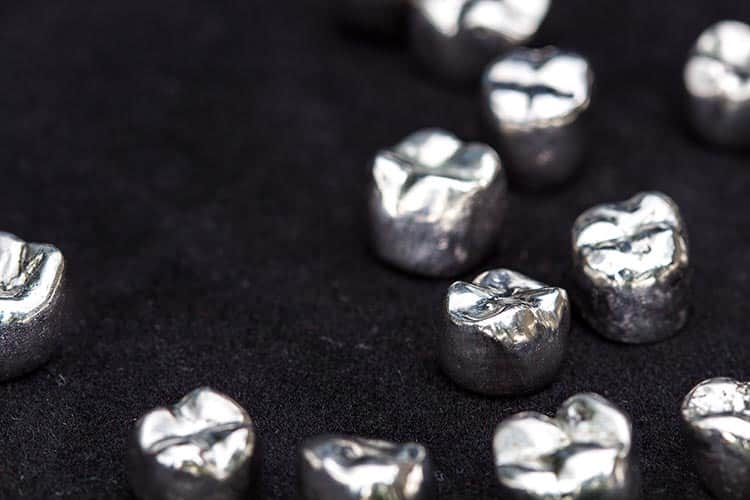
The procedure for placing a stainless steel crown is actually pretty quick. After the tooth is numbed we remove the decay and shape the tooth so that we can fit a stainless steel crown over it. We contour the crown so that it fits perfectly and then we cement it on with a dental cement. The stainless steel crown will stay on the baby tooth until the baby tooth falls out at which time the stainless steel crown will still be cemented to the tooth and fall out with the tooth.
Pulpotomies (baby root canals)
When a cavity has become very large it often will eat through the tooth structure all the way down to the pulp or living tissue of the tooth (see more info on tooth structure here). Often this encroachment of the decay into the pulp will be painful. When the decay has reached the dental pulp, the pulp is generally still alive but the outer areas of the pulp are infected with the bacteria that caused the cavity. If the pulp is not treated and the infected areas are not removed then the bacteria will continue to cause infection and can penetrate all the way into the root canals. If this occurs then the tooth will become abscessed and very painful requiring early removal of the tooth.
To prevent the tooth from abscessing and to relieve any discomfort we can perform a pulpotomy. We often refer to this as a baby root canal but it is not nearly as complicated or difficult of a procedure as a root canal. To perform a pulpotomy we remove the cavity and then access the pulp chamber in the crown of the tooth. We remove the pulp tissue in the crown of the tooth so that all that is left is the healthy pulpal tissue that is down in the roots of the tooth.
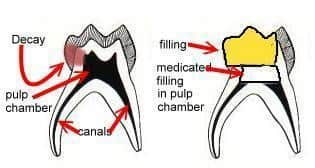
We evaluate the remaining pulp tissue to make sure that it does not show any signs of infection and then place medication in the pulp chamber to make sure that all of the bacteria have been killed. We restore the tooth by placing a medicated filling material in the pulp chamber and placing a stainless steel crown that covers, protects, and strengthens the tooth.
Extractions

Many times primary teeth have to be removed (extracted) due to severe decay, abscess, or for orthodontic reasons like overcrowding. Sometimes cavities progress to the point where a tooth is no longer fixable and the tooth has to be removed. There may be so much tooth structure destroyed that even a stainless steel crown cannot be used to restore the tooth or the tooth may have already become so infected that it is abscessed and causing pain. Not all toothaches mean that a tooth will need to be extracted but if the toothache is causing spontatneous pain (pain that is not related to chewing or manipulating the tooth), pain that wakes your child up at night, or severe pain when biting then the tooth may need an extraction.
Extracting primary teeth is usually much simpler than extracting adult teeth. For many adults the only experience they have had with tooth extractions is the removal of wisdom teeth. Primary teeth extractions are much simpler than wisdom teeth extractions. As always, we insure that the tooth is thoroughly numb and then we remove it. Your child will be numb to any sharp or painful sensations but will still be able to feel pressure or pushing on the tooth. This sensation cannot be alleviated without general anesthesia. The procedure for removing a tooth is generally pretty quick and the recovery time for children is very quick as well. After an extraction you will want your child to “take it easy” for the rest of the day and relax at home.
Space Maintainers
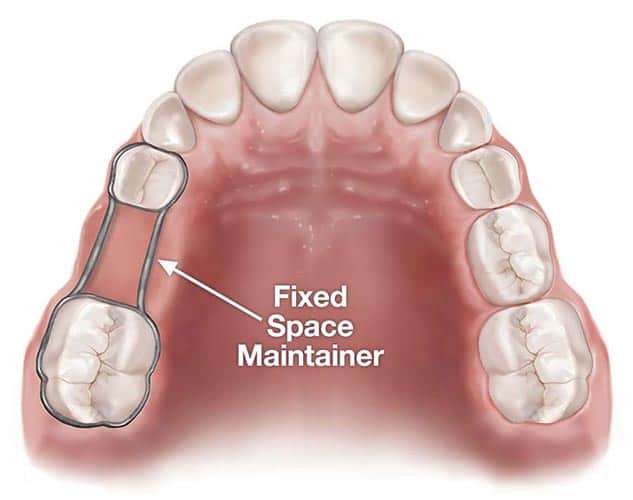
One of a baby tooth’s most important jobs is holding the place for permanent teeth until they erupt. If a primary back tooth is lost prematurely the other teeth around it can drift together and cause crowding. To keep this crowding from occurring a space maintainer can be used whenever a back primary tooth is lost early. Numbing is usually not required to make a space maintainer or to place a space maintainer. The procedure for making and placing a space maintainer generally does take two appointments. At the first appointment an orthodontic band is placed around a tooth and a dental impression is taken. The impression is sent off to a lab and a space maintainer is made. At the second appointment the space maintainer is tried in and any adjustments are made if needed.
The space maintainer is cemented in place using a dental cement. The space maintainer will remain in place until the back permanent teeth begin to erupt at which time it is easily removed. While wearing a space maintainer it is important to avoid sticky candy or chewing gum.
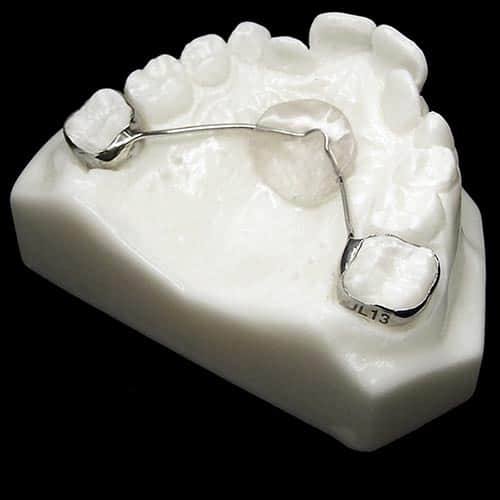
Nance Appliance (for mulitple missing upper teeth)

Lower Lingual Holding Arch(for mulitple missing lower teeth)
Sealants
Click here to read about sealants.
Rubber Dam
A rubber dam is a piece of rubber material that we stretch over a tooth to isolate the tooth from the rest of the mouth. We like to say that this keeps our stuff on our side and your child’s stuff on his/her side. We often call the rubber dam a tooth raincoat. The rubber dam keeps the tongue out of the way and prevents any saliva from getting on the tooth so it can stay dry and we can use our moisture sensitive materials to their fullest potential. Additionally, the rubber dam keeps any of the dental materials and tooth debris from getting in the child’s mouth.
